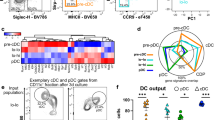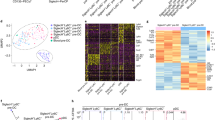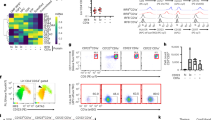Abstract
Dendritic cells (DCs) are immune cells specialized to capture, process and present antigen to T cells in order to initiate an appropriate adaptive immune response. The study of mouse DC has revealed a heterogeneous population of cells that differ in their development, surface phenotype and function. The study of human blood and spleen has shown the presence of two subsets of conventional DC including the CD1b/c+ and CD141+CLEC9A+ conventional DC (cDC) and a plasmacytoid DC (pDC) that is CD304+CD123+. Studies on these subpopulations have revealed phenotypic and functional differences that are similar to those described in the mouse. In this study, the three DC subsets have been generated in vitro from human CD34+ precursors in the presence of fms-like tyrosine kinase 3 ligand (Flt3L) and thrombopoietin (TPO). The DC subsets so generated, including the CD1b/c+ and CLEC9A+ cDCs and CD123+ pDCs, were largely similar to their blood and spleen counterparts with respect to surface phenotype, toll-like receptor and transcription factor expression, capacity to stimulate T cells, cytokine secretion and cross-presentation of antigens. This system may be utilized to study aspects of DC development and function not possible in vivo.
This is a preview of subscription content, access via your institution
Access options
Subscribe to this journal
Receive 12 digital issues and online access to articles
$119.00 per year
only $9.92 per issue
Buy this article
- Purchase on Springer Link
- Instant access to full article PDF
Prices may be subject to local taxes which are calculated during checkout





Similar content being viewed by others
References
Kadowaki N, Antonenko S, Liu YJ . Distinct CpG DNA and polyinosinic-polycytidylic acid double-stranded RNA, respectively, stimulate CD11c− type 2 dendritic cell precursors and CD11c+ dendritic cells to produce type I IFN. J Immunol 2001; 166: 2291–2295.
Krug A, Rothenfusser S, Hornung V, Jahrsdorfer B, Blackwell S, Ballas ZK et al. Identification of CpG oligonucleotide sequences with high induction of IFN-alpha/beta in plasmacytoid dendritic cells. Eur J Immunol 2001; 31: 2154–2163.
O'Keeffe M, Hochrein H, Vremec D, Caminschi I, Miller JL, Anders EM et al. Mouse plasmacytoid cells: long-lived cells, heterogeneous in surface phenotype and function, that differentiate into CD8+ dendritic cells only after microbial stimulus. J Exp Med 2002; 196: 1307–1319.
Vremec D, Pooley J, Hochrein H, Wu L, Shortman K . CD4 and CD8 expression by dendritic cell subtypes in mouse thymus and spleen. J Immunol 2000; 164: 2978–2986.
Shortman K, Heath WR . The CD8+ dendritic cell subset. Immunol Rev 2010; 234: 18–31.
Proietto AI, O'Keeffe M, Gartlan K, Wright MD, Shortman K, Wu L et al. Differential production of inflammatory chemokines by murine dendritic cell subsets. Immunobiology 2004; 209: 163–172.
Naik SH, Proietto AI, Wilson NS, Dakic A, Schnorrer P, Fuchsberger M et al. Cutting edge: generation of splenic CD8+ and CD8− dendritic cell equivalents in Fms-like tyrosine kinase 3 ligand bone marrow cultures. J Immunol 2005; 174: 6592–6597.
Lau-Kilby AW, Kretz CC, Pechhold S, Price JD, Dorta S, Ramos H et al. Interleukin-2 inhibits FMS-like tyrosine kinase 3 receptor ligand (flt3L)-dependent development and function of conventional and plasmacytoid dendritic cells. Proc Natl Acad Sci USA 2011; 108: 2408–2413.
Kuipers H, Schnorfeil FM, Brocker T . Differentially expressed microRNAs regulate plasmacytoid vs. conventional dendritic cell development. Mol Immunol 2010; 48: 333–340.
Sathaliyawala T, O'Gorman WE, Greter M, Bogunovic M, Konjufca V, Hou ZE et al. Mammalian target of rapamycin controls dendritic cell development downstream of Flt3 ligand signaling. Immunity 2010; 33: 597–606.
Sathe P, Pooley J, Vremec D, Mintern J, Jin JO, Wu L et al. The acquisition of antigen cross-presentation function by newly formed dendritic cells. J Immunol 2011; 186: 5184–5192.
MacDonald KP, Munster DJ, Clark GJ, Dzionek A, Schmitz J, Hart DN . Characterization of human blood dendritic cell subsets. Blood 2002; 100: 4512–4520.
Ziegler-Heitbrock L . The CD14+ CD16+ blood monocytes: their role in infection and inflammation. J Leukoc Biol 2007; 81: 584–592.
Ziegler-Heitbrock L, Ancuta P, Crowe S, Dalod M, Grau V, Hart DN et al. Nomenclature of monocytes and dendritic cells in blood. Blood 2010; 116: e74–e80.
Robbins SH, Walzer T, Dembele D, Thibault C, Defays A, Bessou G et al. Novel insights into the relationships between dendritic cell subsets in human and mouse revealed by genome-wide expression profiling. Genome Biol 2008; 9: R17.
Caminschi I, Proietto AI, Ahmet F, Kitsoulis S, Shin Teh J, Lo JC et al. The dendritic cell subtype-restricted C-type lectin Clec9A is a target for vaccine enhancement. Blood 2008; 112: 3264–3273.
Galibert L, Diemer GS, Liu Z, Johnson RS, Smith JL, Walzer T et al. Nectin-like protein 2 defines a subset of T-cell zone dendritic cells and is a ligand for class-I-restricted T-cell-associated molecule. J Biol Chem 2005; 280: 21955–21964.
Huysamen C, Willment JA, Dennehy KM, Brown GD . CLEC9A is a novel activation C-type lectin-like receptor expressed on BDCA3+ dendritic cells and a subset of monocytes. J Biol Chem 2008; 283: 16693–16701.
Sancho D, Mourao-Sa D, Joffre OP, Schulz O, Rogers NC, Pennington DJ et al. Tumor therapy in mice via antigen targeting to a novel, DC-restricted C-type lectin. J Clin Invest 2008; 118: 2098–2110.
Crozat K, Guiton R, Contreras V, Feuillet V, Dutertre CA, Ventre E et al. The XC chemokine receptor 1 is a conserved selective marker of mammalian cells homologous to mouse CD8alpha+ dendritic cells. J Exp Med 2010; 207: 1283–1292.
Bachem A, Guttler S, Hartung E, Ebstein F, Schaefer M, Tannert A et al. Superior antigen cross-presentation and XCR1 expression define human CD11c+CD141+ cells as homologues of mouse CD8+ dendritic cells. J Exp Med 2010; 207: 1273–1281.
Jongbloed SL, Kassianos AJ, McDonald KJ, Clark GJ, Ju X, Angel CE et al. Human CD141+ (BDCA-3)+ dendritic cells (DCs) represent a unique myeloid DC subset that cross-presents necrotic cell antigens. J Exp Med 2010; 207: 1247–1260.
Poulin LF, Salio M, Griessinger E, Anjos-Afonso F, Craciun L, Chen JL et al. Characterization of human DNGR-1+ BDCA3+ leukocytes as putative equivalents of mouse CD8alpha+ dendritic cells. J Exp Med 2010; 207: 1261–1271.
Mittag D, Proietto AI, Loudovaris T, Mannering SI, Vremec D, Shortman K et al. Human dendritic cell subsets from spleen and blood are similar in phenotype and function but modified by donor health status. J Immunol 2011; 186: 6207–6217.
Klechevsky E, Morita R, Liu M, Cao Y, Coquery S, Thompson-Snipes L et al. Functional specializations of human epidermal Langerhans cells and CD14+ dermal dendritic cells. Immunity 2008; 29: 497–510.
Chen W, Antonenko S, Sederstrom JM, Liang X, Chan AS, Kanzler H et al. Thrombopoietin cooperates with FLT3-ligand in the generation of plasmacytoid dendritic cell precursors from human hematopoietic progenitors. Blood 2004; 103: 2547–2553.
Blom B, Ho S, Antonenko S, Liu YJ . Generation of interferon alpha-producing predendritic cell (Pre-DC)2 from human CD34+ hematopoietic stem cells. J Exp Med 2000; 192: 1785–1796.
Ratta M, Rondelli D, Fortuna A, Curti A, Fogli M, Fagnoni F et al. Generation and functional characterization of human dendritic cells derived from CD34 cells mobilized into peripheral blood: comparison with bone marrow CD34+ cells. Br J Haematol 1998; 101: 756–765.
Vremec D, Shortman K . Dendritic cell subtypes in mouse lymphoid organs: cross-correlation of surface markers, changes with incubation, and differences among thymus, spleen, and lymph nodes. J Immunol 1997; 159: 565–573.
Lahoud MH, Proietto AI, Gartlan KH, Kitsoulis S, Curtis J, Wettenhall J et al. Signal regulatory protein molecules are differentially expressed by CD8− dendritic cells. J Immunol 2006; 177: 372–382.
Contreras V, Urien C, Guiton R, Alexandre Y, Vu Manh TP, Andrieu T et al. Existence of CD8alpha-like dendritic cells with a conserved functional specialization and a common molecular signature in distant mammalian species. J Immunol 2010; 185: 3313–3325.
Dorner BG, Dorner MB, Zhou X, Opitz C, Mora A, Guttler S et al. Selective expression of the chemokine receptor XCR1 on cross-presenting dendritic cells determines cooperation with CD8+ T cells. Immunity 2009; 31: 823–833.
Suzuki S, Honma K, Matsuyama T, Suzuki K, Toriyama K, Akitoyo I et al. Critical roles of interferon regulatory factor 4 in CD11bhighCD8alpha− dendritic cell development. Proc Natl Acad Sci USA 2004; 101: 8981–8986.
Tamura T, Tailor P, Yamaoka K, Kong HJ, Tsujimura H, O'Shea JJ et al. IFN regulatory factor-4 and -8 govern dendritic cell subset development and their functional diversity. J Immunol 2005; 174: 2573–2581.
Schiavoni G, Mattei F, Sestili P, Borghi P, Venditti M, Morse HC 3rd et al. ICSBP is essential for the development of mouse type I interferon-producing cells and for the generation and activation of CD8alpha+ dendritic cells. J Exp Med 2002; 196: 1415–1425.
Edwards AD, Diebold SS, Slack EM, Tomizawa H, Hemmi H, Kaisho T et al. Toll-like receptor expression in murine DC subsets: lack of TLR7 expression by CD8 alpha+ DC correlates with unresponsiveness to imidazoquinolines. Eur J Immunol 2003; 33: 827–833.
Proietto AI, Lahoud MH, Wu L . Distinct functional capacities of mouse thymic and splenic dendritic cell populations. Immunol Cell Biol 2008; 86: 700–708.
Jarrossay D, Napolitani G, Colonna M, Sallusto F, Lanzavecchia A . Specialization and complementarity in microbial molecule recognition by human myeloid and plasmacytoid dendritic cells. Eur J Immunol 2001; 31: 3388–3393.
Hochrein H, Shortman K, Vremec D, Scott B, Hertzog P, O'Keeffe M . Differential production of IL-12, IFN-alpha, and IFN-gamma by mouse dendritic cell subsets. J Immunol 2001; 166: 5448–5455.
Schulz O, Edwards AD, Schito M, Aliberti J, Manickasingham S, Sher A et al. CD40 triggering of heterodimeric IL-12 p70 production by dendritic cells in vivo requires a microbial priming signal. Immunity 2000; 13: 453–462.
Acosta-Rodriguez EV, Napolitani G, Lanzavecchia A, Sallusto F . Interleukins 1beta and 6 but not transforming growth factor-beta are essential for the differentiation of interleukin 17-producing human T helper cells. Nat Immunol 2007; 8: 942–949.
Vremec D, Zorbas M, Scollay R, Saunders DJ, Ardavin CF, Wu L et al. The surface phenotype of dendritic cells purified from mouse thymus and spleen: investigation of the CD8 expression by a subpopulation of dendritic cells. J Exp Med 1992; 176: 47–58.
den Haan JM, Lehar SM, Bevan MJ . CD8+ but not CD8− dendritic cells cross-prime cytotoxic T cells in vivo. J Exp Med 2000; 192: 1685–1696.
Pooley JL, Heath WR, Shortman K . Cutting edge: intravenous soluble antigen is presented to CD4 T cells by CD8− dendritic cells, but cross-presented to CD8 T cells by CD8+ dendritic cells. J Immunol 2001; 166: 5327–5330.
Hildner K, Edelson BT, Purtha WE, Diamond M, Matsushita H, Kohyama M et al. Batf3 deficiency reveals a critical role for CD8alpha+ dendritic cells in cytotoxic T cell immunity. Science 2008; 322: 1097–1100.
Idoyaga J, Lubkin A, Fiorese C, Lahoud MH, Caminschi I, Huang Y et al. Comparable T helper 1 (Th1) and CD8 T-cell immunity by targeting HIV gag p24 to CD8 dendritic cells within antibodies to Langerin, DEC205, and Clec9A. Proc Natl Acad Sci USA 2011; 108: 2384–2389.
Hambleton S, Salem S, Bustamante J, Bigley V, Boisson-Dupuis S, Azevedo J et al. IRF8 mutations and human dendritic-cell immunodeficiency. N Engl J Med 2011; 365: 127–138.
Brasel K, de Smedt T, Smith JL, Maliszewski CR . Generation of murine dendritic cells from flt3-ligand-supplemented bone marrow cultures. Blood 2000; 96: 3029–3039.
Drakes ML, Lu L, Subbotin VM, Thomson AW . In vivo administration of flt3 ligand markedly stimulates generation of dendritic cell progenitors from mouse liver. J Immunol 1997; 159: 4268–4278.
Maraskovsky E, Brasel K, Teepe M, Roux ER, Lyman SD, Shortman K et al. Dramatic increase in the numbers of functionally mature dendritic cells in Flt3 ligand-treated mice: multiple dendritic cell subpopulations identified. J Exp Med 1996; 184: 1953–1962.
McKenna HJ, Stocking KL, Miller RE, Brasel K, de Smedt T, Maraskovsky E et al. Mice lacking flt3 ligand have deficient hematopoiesis affecting hematopoietic progenitor cells, dendritic cells, and natural killer cells. Blood 2000; 95: 3489–3497.
O'Keeffe M, Hochrein H, Vremec D, Pooley J, Evans R, Woulfe S et al. Effects of administration of progenipoietin 1, Flt-3 ligand, granulocyte colony-stimulating factor, and pegylated granulocyte-macrophage colony-stimulating factor on dendritic cell subsets in mice. Blood 2002; 99: 2122–2130.
Marroquin CE, Westwood JA, Lapointe R, Mixon A, Wunderlich JR, Caron D et al. Mobilization of dendritic cell precursors in patients with cancer by flt3 ligand allows the generation of higher yields of cultured dendritic cells. J Immunother 2002; 25: 278–288.
Schreibelt G, Klinkenberg LJ, Cruz LJ, Tacken PJ, Tel J, Kreutz M et al. The C-type lectin receptor CLEC9A mediates antigen uptake and (cross-)presentation by human blood BDCA3+ myeloid dendritic cells. Blood 2012; 119: 2284–2292.
Acknowledgements
LW is supported by National Health and Medical Research Council of Australia (NHMRC) Research Fellowships. AWR is supported by a Victorian Cancer Agency Fellowship. This work was also funded by an NHMRC Project Grant (LW) and an NHMRC Program Grant (AWR). This work was made possible through Victorian State Government Operational Infrastructure Support and Australian Government NHMRC IRIIS. We are grateful to the members of the FACS Laboratory for their excellent assistance with cell sorting. We thank Mireille Lahoud for the antibody against CLEC9A, Gaetano Naselli for advice on the cytokine multiplex assay and Naomi Sprigg for the acquisition of samples for this research.
Author information
Authors and Affiliations
Corresponding authors
Rights and permissions
About this article
Cite this article
Proietto, A., Mittag, D., Roberts, A. et al. The equivalents of human blood and spleen dendritic cell subtypes can be generated in vitro from human CD34+ stem cells in the presence of fms-like tyrosine kinase 3 ligand and thrombopoietin. Cell Mol Immunol 9, 446–454 (2012). https://doi.org/10.1038/cmi.2012.48
Received:
Revised:
Accepted:
Published:
Issue Date:
DOI: https://doi.org/10.1038/cmi.2012.48
Keywords
This article is cited by
-
Engineered niches support the development of human dendritic cells in humanized mice
Nature Communications (2020)
-
Engineering dendritic cell vaccines to improve cancer immunotherapy
Nature Communications (2019)
-
Murine Flt3 ligand-generated plasmacytoid and conventional dendritic cells display functional differentiation in activation, inflammation, and antigen presentation during BCG infection in vitro
In Vitro Cellular & Developmental Biology - Animal (2017)
-
Human dendritic cell subsets and function in health and disease
Cellular and Molecular Life Sciences (2015)



